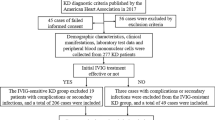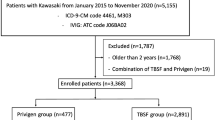Abstract
Background
The use of corticosteroids in Kawasaki disease (KD) is still controversial. The aim of this study was to investigate the safety and effectiveness of modified methylprednisolone (mPSL) regimen as an initial treatment for refractory KD.
Methods
This is a real-world observational study. We identified refractory KD with a self-developed scoring system. Patients were divided into the intravenous immunoglobulin (IVIG) + mPSL group and the IVIG group. Clinical outcomes and changes in coronary arteries after the treatment during a 12-week period were observed. Propensity-score matching was used to analyze those patients with similar baseline characteristics.
Results
Of a total of 168 patients, 104 patients were assigned into the IVIG group and 64 patients into the IVIG + mPSL group. The therapeutic response rate of the IVIG + mPSL group was significantly higher than that of the IVIG group (98.4 vs 76.0%, P < 0.05). The IVIG + mPSL group had a shorter duration of fever and a higher rate of C-reactive protein decline than the IVIG group (1.17 ± 0.64 vs 1.81 ± 1.16 days; 88.1 vs 83.5%; P < 0.05). The luminal diameter and Z-score of the left circumflex coronary artery (LCX) were significantly smaller and lower in the IVIG + mPSL group than that in the IVIG group at weeks 2 and 12.
Conclusions
Modified mPSL regimen has minimal side effects. It might improve the initial response to IVIG and decrease the dilation of LCX for refractory KD.
Impact
-
Modified mPSL regimen (2–4 mg/kg/day, divided into 2–3 doses for 3–5 days, then 1 mg/kg/day, once a day for 3–5 days, then oral prednisone was tapered over 3–5 weeks in 5–7 days steps) as an intensive initial treatment can decrease LCX dilation in high-risk IVIG-resistant KD patients.
-
Our self-developed scoring system has been proven validated and can be used to identify high-risk IVIG-resistant KD patients in North China.
-
The present study provides an alternative therapeutic regimen for high-risk refractory KD patients.
Similar content being viewed by others
Log in or create a free account to read this content
Gain free access to this article, as well as selected content from this journal and more on nature.com
or
References
McCrindle, B. W. et al. Diagnosis, treatment, and long-term management of kawasaki disease: a scientific statement for health professionals from the American Heart Association. Circulation 135, e927–e999 (2017).
Yeung, R. S. Kawasaki disease: update on pathogenesis. Curr. Opin. Rheumatol. 22, 551–560 (2010).
Kim, J. Y. & Kim, H. J. A case of Kawasaki disease with coronary aneurysm responding to the 4th IVIG treatment. Case Rep. Cardiol. 2014, 821812 (2014).
Burns, J. C., Capparelli, E. V., Brown, J. A., Newburger, J. W. & Glode, M. P. Intravenous gamma-globulin treatment and retreatment in Kawasaki disease. Pediatr. Infect. Dis. J. 17, 1144–1148 (1998).
Adachi, S. et al. High regression rate of coronary aneurysms developed in patients with immune globulin-resistant Kawasaki disease treated with steroid pulse therapy. Tohoku J. Exp. Med. 220, 285–290 (2010).
Wardle, A. J., Connolly, G. M., Seager, M. J. & Tulloh, R. M. Corticosteroids for the treatment of Kawasaki disease in children. Cochrane Database Syst. Rev. 1, CD011188 (2017).
Hur, G. et al. Infliximab treatment for intravenous immunoglobulin-resistant Kawasaki disease: a multicenter study in Korea. Korean Circ. J. 49, 183–191 (2019).
Suzuki, H. et al. Cyclosporin A treatment for Kawasaki disease refractory to initial and additional intravenous immunoglobulin. Pediatr. Infect. Dis. J. 30, 871–876 (2011).
Tremoulet, A. H. et al. Calcineurin inhibitor treatment of intravenous immunoglobulin-resistant Kawasaki disease. J. Pediatr. 161, 506–512 (2012).
Loomba, R. S., Raskin, A., Gudausky, T. M. & Kirkpatrick, E. Role of the Egami score in predicting intravenous immunoglobulin resistance in Kawasaki disease among different ethnicities. Am. J. Ther. 23, e1293–e1299 (2016).
Kobayashi, T. et al. Prediction of intravenous immunoglobulin unresponsiveness in patients with Kawasaki disease. Circulation 113, 2606–2612 (2006).
Davies, S. et al. Predicting IVIG resistance in UK Kawasaki disease. Arch. Dis. Child. 100, 366–368 (2015).
Sano, T. et al. Prediction of non-responsiveness to standard high-dose gamma-globulin therapy in patients with acute Kawasaki disease before starting initial treatment. Eur. J. Pediatr. 166, 131–137 (2007).
Ye, X. & Zhang, J. Evaluation of the efficiency of different scoring systems in predicting intravenous immunoglobulin unresponsiveness in Kawasaki disease. Chin. J. Evid. Based Pediatr. 11, 337–340 (2016).
Takeshita, S., Kanai, T., Kawamura, Y., Yoshida, Y. & Nonoyama, S. A comparison of the predictive validity of the combination of the neutrophil-to-lymphocyte ratio and platelet-to-lymphocyte ratio and other risk scoring systems for intravenous immunoglobulin (IVIG) resistance in Kawasaki disease. PLoS ONE 12, e0176957 (2017).
Park, H. M., Lee, D. W., Hyun, M. C. & Lee, S. B. Predictors of nonresponse to intravenous immunoglobulin therapy in Kawasaki disease. Korean J. Pediatr. 56, 75–79 (2013).
Lin, M. T. et al. Risk factors and derived formosa score for intravenous immunoglobulin unresponsiveness in Taiwanese children with Kawasaki disease. J. Formos. Med. Assoc. 115, 350–355 (2016).
Xiao, L. & Zhang, J. Progress of Predictive Scoring Systems of Intravenous Immunoglobulin Unresponsiveness in Children with Kawasaki Disease. J. Pediatr. Pharm. 25, 55–58 (2019).
Qian, W., Tang, Y., Yan, W., Sun, L. & Lv, H. A comparison of efficacy of six prediction models for intravenous immunoglobulin resistance in Kawasaki disease. Ital. J. Pediatr. 44, 33 (2018).
Kobayashi, T. et al. Efficacy of immunoglobulin plus prednisolone for prevention of coronary artery abnormalities in severe Kawasaki disease (RAISE study): a randomised, open-label, blinded-endpoints trial. Lancet 379, 1613–1620 (2012).
Okada, K. et al. Pulse methylprednisolone with gammaglobulin as an initial treatment for acute Kawasaki disease. Eur. J. Pediatr. 168, 181–185 (2009).
Ogata, S. et al. Corticosteroid pulse combination therapy for refractory Kawasaki disease: a randomized trial. Pediatrics 129, e17–e23 (2012).
Kobayashi, T. et al. Risk stratification in the decision to include prednisolone with intravenous immunoglobulin in primary therapy for Kawasaki disease. Pediatr. Infect. Dis. J. 28, 498–502 (2009).
Yang, S., Song, R., Zhang, J., Li, X. & Li, C. Predictive tool for intravenous immunoglobulin resistance of Kawasaki disease in Beijing. Arch. Dis. Child. 104, 262–267 (2019).
Kobayashi, T. et al. A new Z score curve of the coronary arterial internal diameter using the lambdamusigma method in a pediatric population. J. Am. Soc. Echocardiogr. 29, 794–801 (2016).
Kato, H., Koike, S. & Yokoyama, T. Kawasaki disease: effect of treatment on coronary artery involvement. Pediatrics 63, 175–179 (1979).
Hashino, K., Ishii, M., Iemura, M., Akagi, T. & Kato, H. Re-treatment for immune globulin-resistant Kawasaki disease: a comparative study of additional immune globulin and steroid pulse therapy. Pediatr. Int. 43, 211–217 (2001).
Sundel, R. P., Baker, A. L., Fulton, D. R. & Newburger, J. W. Corticosteroids in the initial treatment of Kawasaki disease: report of a randomized trial. J. Pediatr. 142, 611–616 (2003).
Okubo, Y. et al. Association between dose of glucocorticoids and coronary artery lesions in Kawasaki disease. Arthritis Care Res. 70, 1052–1057 (2018).
Chen, S. et al. Coronary artery complication in Kawasaki disease and the importance of early intervention: a systematic review and Meta-analysis. JAMA Pediatr. 170, 1156–1163 (2016).
Chang, L. S. & Kuo, H. C. The role of corticosteroids in the treatment of Kawasaki disease. Expert Rev. Anti Infect. Ther. 18, 155–164 (2020).
Sleeper, L. A. et al. Evaluation of Kawasaki disease risk-scoring systems for intravenous immunoglobulin resistance. J. Pediatr. 158, 831–835. e3 (2011).
Fabi, M. et al. Inability of Asian risk scoring systems to predict intravenous immunoglobulin resistance and coronary lesions in Kawasaki disease in an Italian cohort. Eur. J. Pediatr. 178, 315–322 (2019).
Fu, P. P., Du, Z. D. & Pan, Y. S. Novel predictors of intravenous immunoglobulin resistance in Chinese children with Kawasaki disease. Pediatr. Infect. Dis. J. 32, e319–e323 (2013).
Song, R., Yao, W. & Li, X. Efficacy of four scoring systems in predicting intravenous immunoglobulin resistance in children with Kawasaki disease in a children’s hospital in Beijing, North China. J. Pediatr. 184, 120–124 (2017).
Tang, Y. et al. Prediction of intravenous immunoglobulin resistance in Kawasaki disease in an East China population. Clin. Rheumatol. 35, 2771–2776 (2016).
Grignani, R., Rajgor, D. D., Leow, Y. G., Heng, C. K. & Quek, S. C. A novel model for predicting non-responsiveness to intravenous immunoglobulins in Kawasaki disease: the Singapore experience. J. Paediatr. Child Health 55, 962–967 (2019).
Shin, J., Lee, H. & Eun, L. Verification of current risk scores for Kawasaki disease in Korean children. J. Korean Med. Sci. 32, 1991–1996 (2017).
Acknowledgements
This study was supported by the following grants: Science Foundation for Clinical Technical Innovation Project of Beijing Municipal Administration of Hospital (XMLX201612), “Peak Climbing” Talents Development Program of Beijing Hospital Authority (DFL20181301), Key Project of Capital Clinical Characteristic Application Research (Z181100001718189), and Research Project of Capital Institute of Pediatrics (PY-2019-11).
Author information
Authors and Affiliations
Contributions
X.L. conceptualized and designed the study, interpreted the data, and revised it critically for important intellectual content. M.Z. and Y.Z. acquired and analyzed the data, and drafted the initial manuscript. S.Y. contributed to acquire and analyze the data. L.S., A.L. and Y.L. contributed to treatment and follow-up of patients and critically reviewed the manuscript for important intellectual content. All authors approved the final manuscript as submitted
Corresponding author
Ethics declarations
Competing interests
The authors declare no competing interests.
Patient consent
Parental/guardian consent was obtained.
Ethics approval
All procedures regarding this work comply with the ethical standards of the relevant national guidelines on human experimentation and with the Declaration of Helsinki, as revised in 2008. The study was approved by the Ethics Committee of the Capital Institute of Pediatrics (No. SHERLL 2015040).
Additional information
Publisher’s note Springer Nature remains neutral with regard to jurisdictional claims in published maps and institutional affiliations.
Supplementary information
Rights and permissions
About this article
Cite this article
Zhang, M., Zheng, Y., Li, X. et al. Refractory Kawasaki disease: modified methylprednisolone regimen decreases coronary artery dilatation. Pediatr Res 91, 1542–1550 (2022). https://doi.org/10.1038/s41390-021-01576-6
Received:
Revised:
Accepted:
Published:
Issue date:
DOI: https://doi.org/10.1038/s41390-021-01576-6
This article is cited by
-
Dynamic changes of serum matrix metalloproteinases and tissue inhibitors in Kawasaki disease: implications for coronary artery lesions persistence
Italian Journal of Pediatrics (2025)
-
An Update on Kawasaki Disease
Current Rheumatology Reports (2025)
-
Aspirin/immune-globulin/methylprednisolone
Reactions Weekly (2022)



